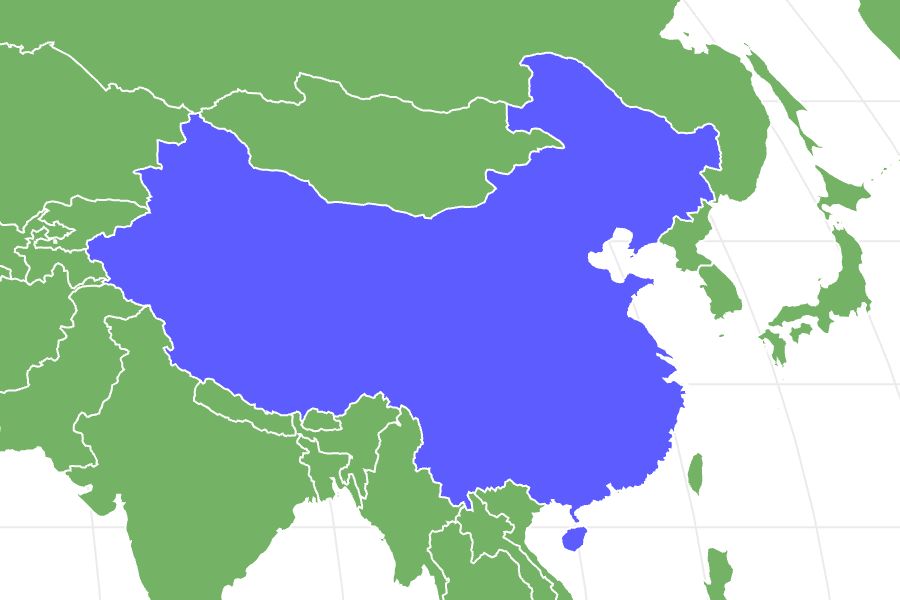Shih Tzu
Canis Lupus
Can live for up to 15 years!
Advertisement
Shih Tzu Scientific Classification
- Kingdom
- Animalia
- Phylum
- Chordata
- Class
- Mammalia
- Order
- Carnivora
- Family
- Canidae
- Genus
- Canis
- Scientific Name
- Canis Lupus
Read our Complete Guide to Classification of Animals.
Shih Tzu Conservation Status
Shih Tzu Facts
Shih Tzu as a Pet:
- General Health
- Energy Level
- Shedability
- Trainability
- Intelligence
- Tendency to Chew
- Size
- Family and kid friendliness
- Yappiness / Barking
- High
- Separation Anxiety
- High
- Preferred Temperature
- Average climate
- Exercise Needs
- Low
- Friendly With Other Dogs
- Moderate
- Pure bred cost to own
- $2,000 to up to $10,000
- Dog group
- Toy
- Male weight
- 9-16 lbs
- Female weight
- 9-16 lbs
This post may contain affiliate links to our partners like Chewy, Amazon, and others. Purchasing through these helps us further the A-Z Animals mission to educate about the world's species.
View all of the Shih Tzu images!
The Shih Tzu is a toy dog. Its Chinese name means “little lion.”
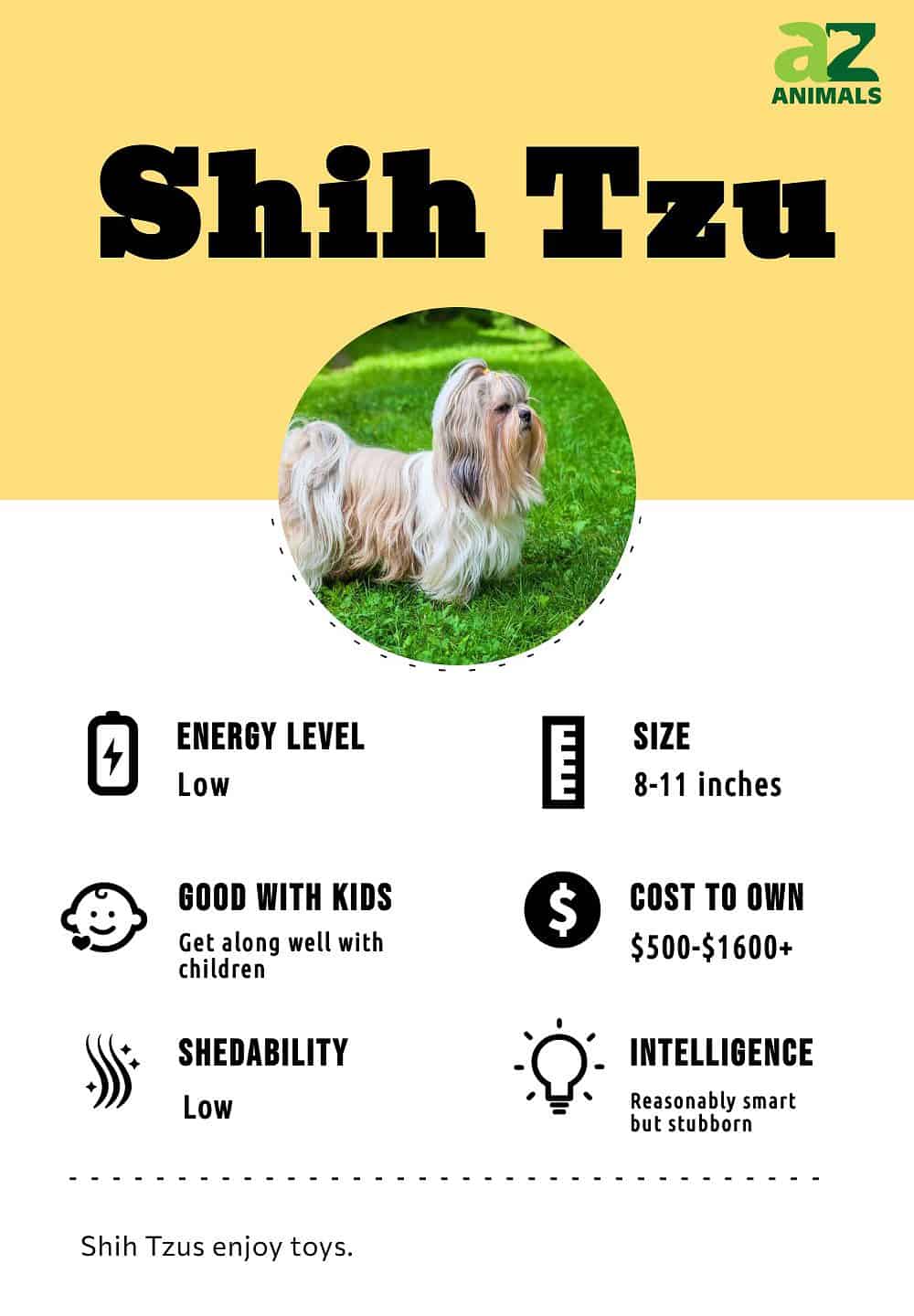
The Shih Tzu is an ancient breed, dating back 1,000 years and thought to have originated from the cold mountains of Tibet, thus the long double-coat. Chinese royals enjoyed the warmth of the dog lying on their feet in bed. The emperor’s breeders most likely developed the dog from the Lhaso Apso and the Pekingese. The breed was introduced to England in 1928 and has since become one of the most popular toy dogs in the United Kingdom and the United States. They still treat their owners like royalty, no matter who they might be.
See all of our expert product reviews.
The Shih Tzu has coat colors of brown, white, gold, black, brindle, grey, or a combination of these. Its averages lifespan is 13 years. The small size and easygoing personality make for a great companion dog.
You can check out here incredible facts about Shih Tzus.
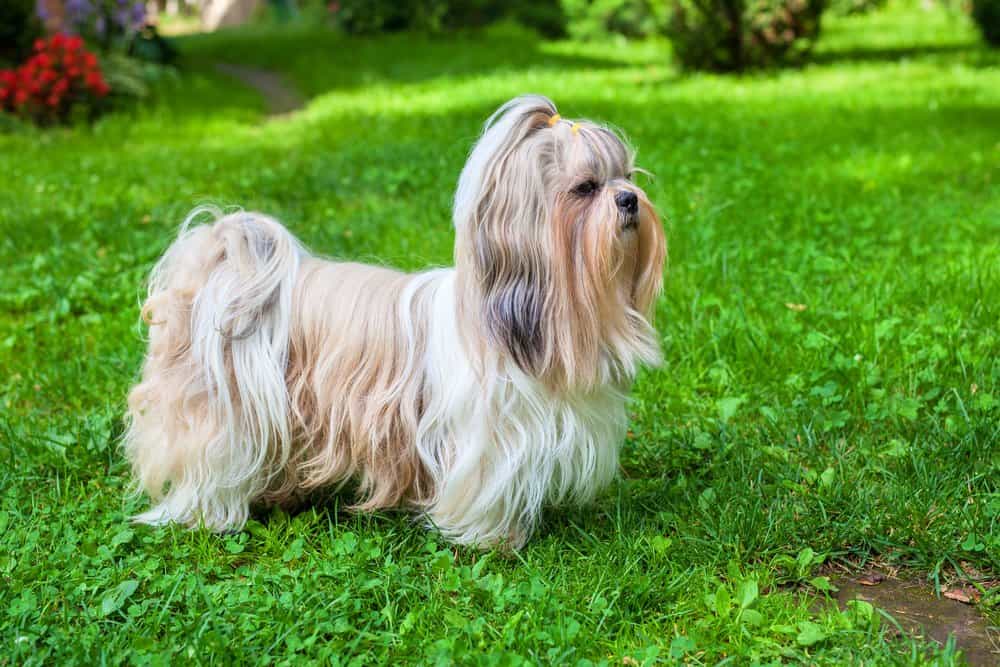
The long hair on a Shih Tzu requires frequent brushing.
©chaoss/Shutterstock.com
3 Pros and Cons of Ownership
| Pros! | Cons! |
| They’re a toy dog breed. They don’t need a lot of space, and are perfectly happy as long as they have other dogs or people to be around. They can come with you to many places. | They need regular brushing. With a long double-coat, they need frequent grooming. |
| They’re very loyal. Shih Tzus are famous for being fiercely loyal and even protective of their owners or family. They tend to get attached to one person in particular. | They have certain health issues. Some are hereditary conditions. They include eye, breathing and back issues. |
| They’re hardy. For such a small dog, they are sturdy in spite of any health issues. | They get anxious. This breed separation anxiety, also known as owner absent behavior. They do not do well with sudden changes in routines. |
Health and Entertainment for your Shih Tzu
See all of our expert product reviews.
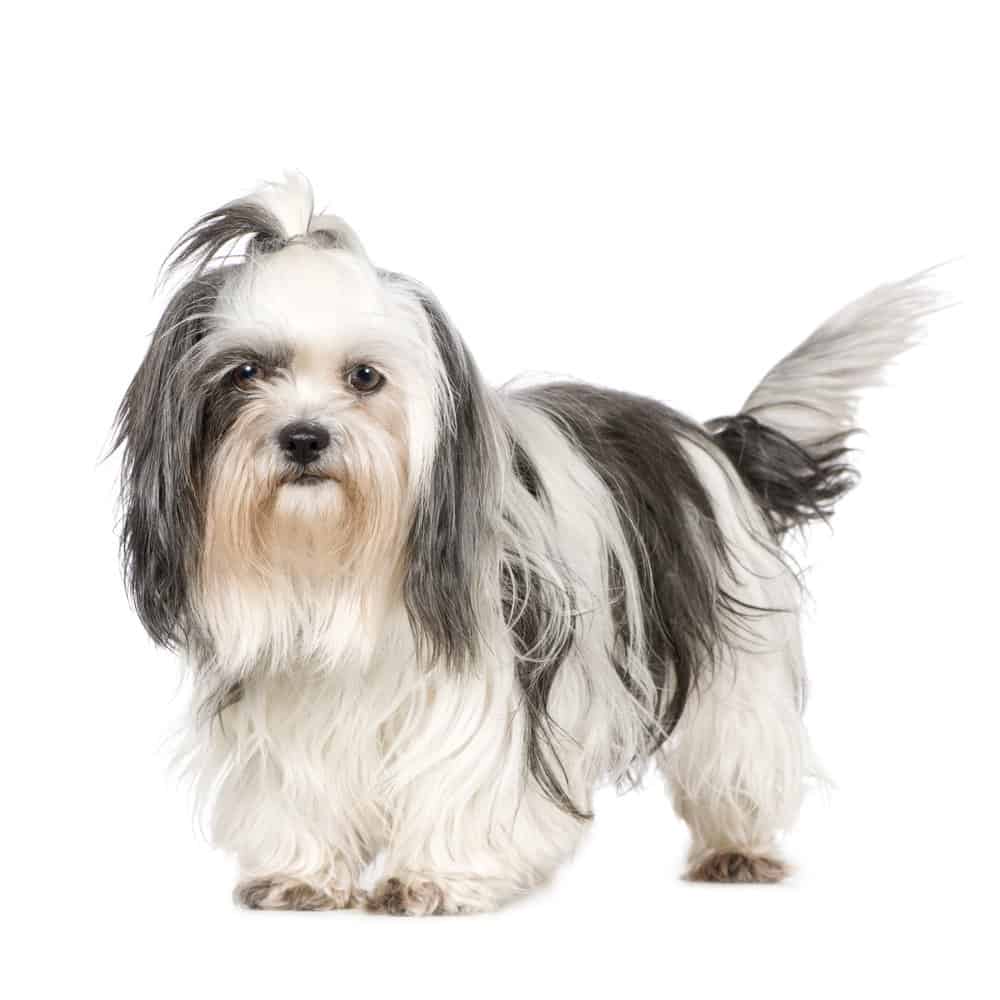
Shih Tzus are small lap dogs bred to be companions.
©Eric Isselee/Shutterstock.com
Size and Weight
The Shih Tzu is a small toy-sized dog with a large, round face; large, brown eyes; and a soft, long double-coat. It has an average height of 10″ for males and 8″ for females. Males and females weigh 9-16 lbs fully grown. Shih Tzu puppies weigh 1.25-4lbs at 8 weeks of age and are considered fully grown at 10 months.
| Height | Weight | |
| Male | 8-11 in | 9-16 lbs |
| Female | 8-11 in | 9-16 lbs |
Common Health Issues
There are a few common health issues Shih Tzus have, some which are hereditary conditions. Breathing problems due to the shape of their head (brachycephalic airway obstructive syndrome) causes difficulty breathing and can require surgery in severe cases. Eye issues causing irritation can occur at any age with the most common being epiphora, where the fur scratches the conjunctiva and the cornea, requiring prescription eye drops from a veterinarian. Many Shih Tzus experience ear infections, and invertebral disk disease is common in toy dog breeds. Hypothyroidism as a result of Cushing’s disease (hyperadrenocortism) tends to affect middle-aged dogs. The breed tends to have teeth problems more often than other dogs. Liver problems, allergies and kidney disease are also unique to the breed. Finally, they are prone to obesity. In short, the most common health issues with Shih Tzus are:
- Invertebral disk disease and other bone problems
- Breathing problems and heart disease
- Eye issues
- Dental disease
- Hypothyroidism
- Ear infections
- Liver problems
- Kidney disease
- Allergies
- Obesity

Shih Tzus are people-oriented homebodies.
©Angel LeBlanc/Shutterstock.com
Temperament
Shih Tzus have a very people-oriented, housebound personality. They are stubborn, affectionate, happy and easygoing in temperament. They do not like to be left alone and demand attention to the point of becoming spoiled. They were not bred to guard, hunt, or anything else except to be a companion, so they don’t let you ignore them. One of the traits of this toy breed is being a lap dog with a natural tendency for human companionship. Another is that they don’t tend to excessively bark, unlike other toy breeds.
Shih Tzus are great in dog shows. They are proud and arrogant-looking but are sweet and less demanding and noisy than other toy breeds. Around other pets, they are peaceful, but they need socialization to learn how to trust strangers in order to be friendly or polite to them. They tend to get along well with other dogs, no matter their size.
Care
New pet owners will find unique differences in caring for Shih Tzus, especially Shih Tzu puppies. Shih Tzus have breed-specific factors such as the need for regular brushing and grooming and hereditary conditions that must be carefully taken into consideration.
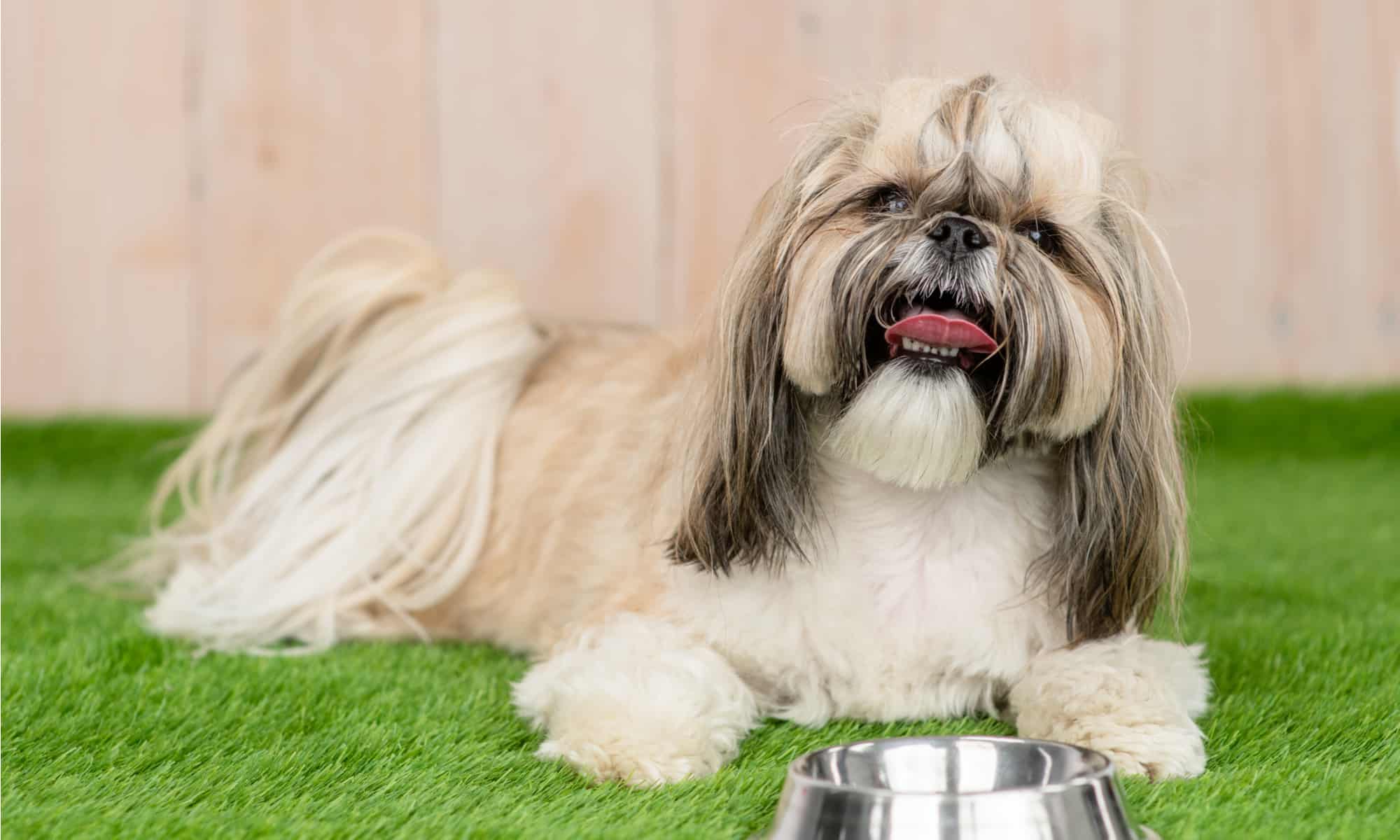
There is a breed-specific dog food for Shih Tzus..
©Ermolaev Alexander/Shutterstock.com
Best Dog Food
Shih Tzus have different health considerations compared to other dog breeds. So, as A Shih Tzu owner, you want to feed your dog a nutritious food that sets them up for a long, healthy, happy life. We recommend looking into legume-free dog food, given the link between some legumes and heart failure, and Shih Tzus’ heart disease risk.
Shih Tzu puppy food: Because of their unique build and health issues, Shih Tzus need a breed-specific food, if possible. Such a food is especially made for their underbite and short muzzle. It also has specific nutrients, antioxidants, proteins and prebiotics to support their immune system, skin, coat and digestion. Otherwise, get a premium dog food. Puppies under 3 months of age should be free-fed, and from 3-12 months they should be fed 3 meals a day.
Shih Tzu adult dog food: Dry food is better for their teeth than wet food. They should be fed premium dog food 2 to 3 times a day. Grain-free or gluten-free formulas can decrease or eliminate skin and digestive problems.
At A-Z Animals, we recognize Royal Canin Shih Tzu Adult Breed Specific Dry Dog Food as the best dog food for Shih Tzus.
When it comes to covering Shih Tzus’ host of potential health complications, this breed-specific food does it all. It excludes the legumes that experts suspect to cause heart failure in dogs, and it comes in a crunchy, dry kibble to help remove plaque and tartar from Shih Tzus’ teeth. It’s loaded with calcium for bone and dental health, with a balance of protein and fiber to keep Shih Tzus full so they eat just the right amount and maintain a healthy weight.
Follow this link to purchase Royal Canin Shih Tzu Breed Specific Dry Dog Food.
- Formulated to meet the nutritional needs of purebred Shih Tzus
- Kibble shape designed specifically for a Shih Tzu’s short muzzle and underbite
- Maintain your Shih Tzu’s long coat with omega-3 fatty acids, omega-6 fatty acids, and biotin
- Contains highly digestible proteins
Best Insurance
The best type of insurance for your Shih Tzu is one that considers their breed, age and any existing, diagnosed health conditions for the best coverage. Each coverage package has different deductible levels to choose from depending on the amount you’re willing to spend before the insurance kicks in. You should shop around and consider at least 2 or 3 different insurance companies.
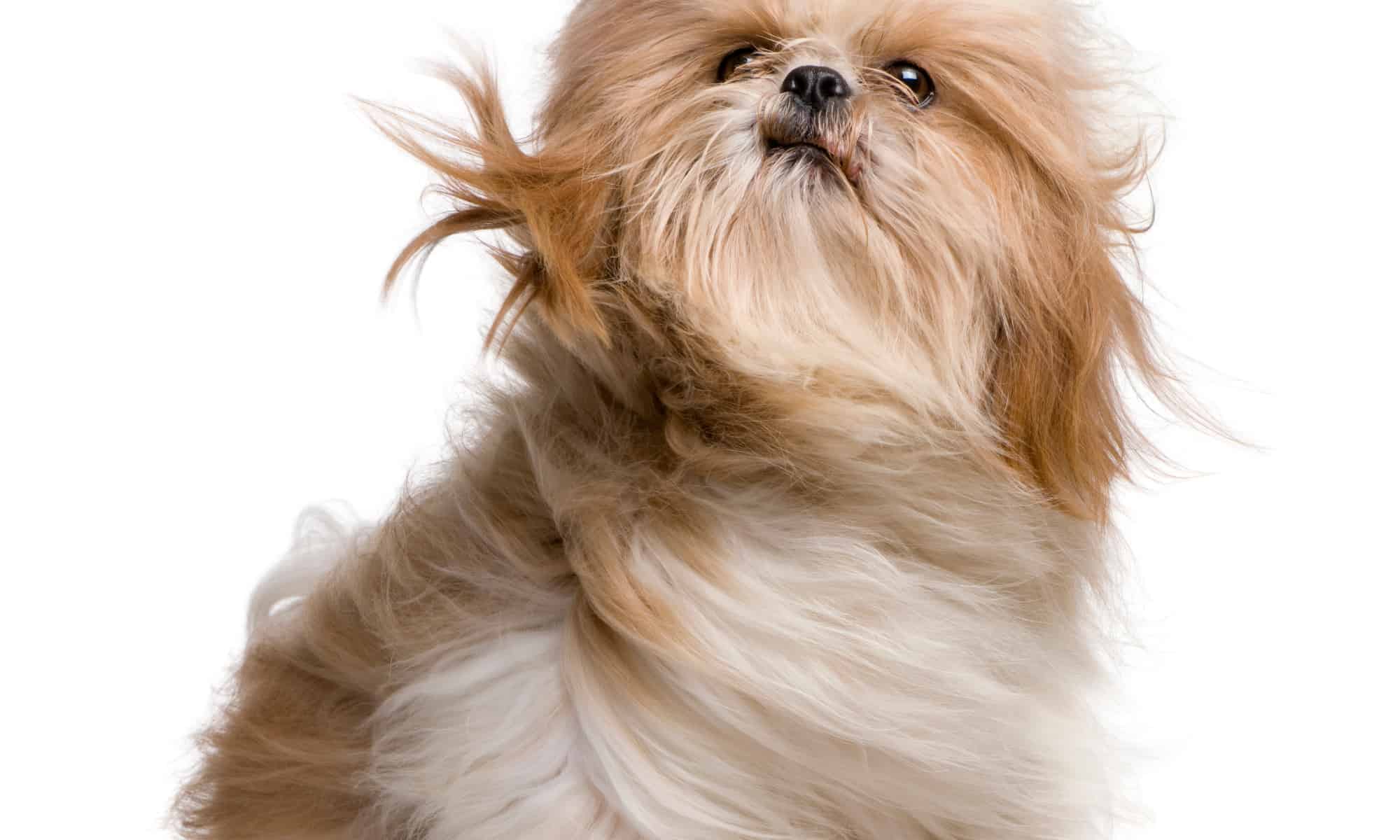
The right brush, like the Musment Self Cleaning Slicker Brush, can make grooming more pleasurable for you and your dog.
©iStock.com/GlobalP
Maintenance And Grooming
Like other dogs, Shih Tzus need regular baths about once a month or every 3 to 4 weeks. During puppyhood, they need more bathing due to soiling themselves. They also need daily grooming to keep their coats soft and tangle-free. For those with long coats, they need grooming everyday; those with medium-length coats need grooming every 2 days, while those with short or shaved coats need grooming every 3 days. Be sure to purchase both fine-toothed and a broader-toothed brushes to thoroughly groom their long double-coats. Their coat colors can change over time and can fade once they reach adulthood.
Training
Shih Tzus need to be trained as soon as possible during their puppyhood. They are known for being stubborn and difficult to housebreak. Although they can learn tricks, they also have their own mind. Treats and snacks help to encourage them.
Exercise
Adult Shih Tzus only need the exercise that comes from playing in the house or yard and daily walks twice a day for 20-30 minutes. They also enjoy toys. If they do not get enough exercise, they will become bored and show behavioral problems such as excessive barking, chewing, or overeating. They also have a higher impulse to chase and catch things than other dog breeds. However, they have a lower energy level than others.
Puppies
Taking care of Shih Tzu puppies means fulfilling their playtime, food and grooming needs. They need socialization and housebreaking early on. They also need a lot of attention.
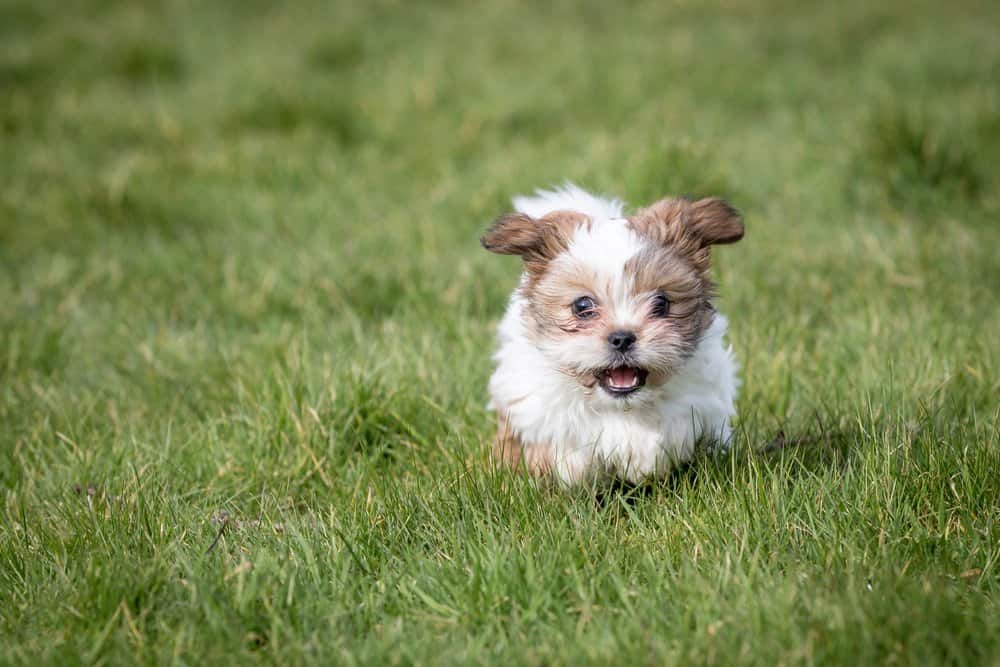
©Daz Stock/Shutterstock.com
Children
Shih Tzus get along well with children. However, they’re not a good choice for families with very young children due to their small size, which increases their risk of injury. Those who are badly socialized since puppyhood can bite children.
Types of Shih Tzu
There are not any other distiinctive breeds that have developed from the Shih Tzu. A Google search might result in lists of different types of Shih Tzus, but the lists all have differences and are not describing breeds approved by the American Kennel Club. The main variances in different types of Shih Tzus are just colors (Brown, Black, Brindle, White, Gold, and Blue-Eyed) or size.
The Traditional Shih Tzu is also, oddly enough, called the American Shih Tzu and is the standard size. The European Shih Tzu is the same dog, just a little smaller. The Imperial Shih Tzu (aka Japanese Shih Tzu) is smaller still and not a purebred. The smallest is the Teacup Shih Tzu. These different colors and sizes were achieved by selective breeding, but the dog itself is essentially the same.
The Maltese Shih Tzu originated in the 1990s, but it is a mix of the Maltese dog and the Shih Tzu. Similarly, there is a Japanese Shih Tzu that is a cross between a Japanese Chin and the Shish Tzu, and the Teddy Bear Shih Tzu that is a cross with a Bichon Frise and/or a Poodle. None of these are recognized by the American Kennel Club.
Similar Dogs
Other dog breeds similar to Shih Tzus are the Maltese, Pekingese and the Llasa Apso as well as any popular Shih Tzu mix, such as Shih Poo (Shih Tzu Toy Poodle mix), Shorkie (Shih Tzu Yorkie mix) or Havashu (Shih Tzu Havanese mix). All fall under the scientific name of Canis lupus for domestic dog.
- Maltese: Looks similar but with higher energy and only one coat.
- Pekingese: Slightly smaller than the Shih Tzu, its coat is less dense, less smooth and shorter.
- Lhasa Apso: A close lookalike that’s also from Tibet, this breed has a longer snout and a hard coat.
Famous
With a history going back 1,000 years, the “little lion dog” or “chrysanthemum dog” is one of the most popular breeds. It has been a prominent feature in several films and a couple of video games:
- Miss Agnes in Best in Show, a mockumentary comedy film from 2000
- Bonny in Seven Psychopaths, a dark comedy from 2012
- Daisy in The Secret Life of Pets 2, a 3D animated comedy film from 2019
- Isabelle, the mascot of the Animal Crossing series, first appeared in Animal Crossing: New Leaf (2012)
- Isabelle is also a playable character in Super Smash Bros. Ultimate.
Popular Names for Shih Tzus
Some of the most popular names for this breed are:
- Charlie
- Max
- Jack
- Buddy
- Leo
- Daisy
- Gigi
- Zoey
- Poppy
- Lola
Shih Tzu FAQs (Frequently Asked Questions)
How long do Shih Tzu dogs live?
Shih Tzus can live for up to 18 years but typically live between 10 to 16.
How do you pronounce Shih Tzu?
Westerners pronounce the name “Sheed-zoo” or “Sheet-su,” while the Chinese say “Sher-zer.”
Are Shih Tzus good pets?
Shih Tzus are excellent companion dogs, especially for people living in small apartments or who are seniors.
Do Shih Tzus shed?
No, they do not shed as much as other dog breeds and are good for people with allergies. They only shed when being bathed or brushed. The exception is only when they turn one and change their coats.
Do Shih Tzus bark a lot?
They can, especially if they were not socialized well during puppyhood. Most, however, do not bark as much as other toy dog breeds.
How much does a Shih Tzu cost to own?
A Shih Tzu can cost anywhere from $2,000 to up to $10,000 depending on the breeding, but the average price is $500-$1,500. Show-quality dogs cost more.
Are Shih Tzus good with kids?
Yes, they are great with kids as long as they have generally been socialized well since puppyhood.
Are Shih Tzus herbivores, carnivores, or omnivores?
Shih Tzus are Omnivores, meaning they eat both plants and other animals.
What Kingdom do Shih Tzus belong to?
Shih Tzus belong to the Kingdom Animalia.
What class do Shih Tzus belong to?
Shih Tzus belong to the class Mammalia.
What phylum to Shih Tzus belong to?
Shih Tzus belong to the phylum Chordata.
What family do Shih Tzus belong to?
Shih Tzus belong to the family Canidae.
What order do Shih Tzus belong to?
Shih Tzus belong to the order Carnivora.
What type of covering do Shih Tzus have?
Shih Tzus are covered in Hair.
What genus do Shih Tzus belong to?
Shih Tzus belong to the genus Canis.
What is an interesting fact about Shih Tzus?
Shih Tzus can live for up to 15 years!
What is the scientific name for the Shih Tzu?
The scientific name for the Shih Tzu is Canis Lupus.
What are the differences between Pekingese and Shih Tzus?
The main differences between Pekingese and Shih Tzus are body shape, face shape, coat, and temperament.
What's the difference between Shih Tzus and Yorkies?
The main difference between Shih Tzus and Yorkies is their coat types and colors. Shih Tzus are also less mischievous compared to Yorkies.
What's the difference between Shih Tzus and Havanese dogs?
The Shih Tzu weighs more than the Havanese on average. Both of these dogs have long and beautiful coats, but the Shih Tzu is used more in showmanship compared to the Havanese. Finally, the Havanese originated in Cuba, while the Shih Tzu originated in China.
What are the differences between Shih Poos and Shih Tzus?
The main difference between Shih Poos and Shih Tzus is their energy level. Other notable differences include size, fur texture, color, temperament, and trainability.
What are the key differences between Maltipoos and Shih Tzus?
The key differences between Maltipoos and Shih Tzus are size, coat, temperament, energy levels, trainability, and breed type.
Thank you for reading! Have some feedback for us? Contact the AZ Animals editorial team.
Sources
- My Dog's Name (1970) https://www.mydogsname.com/200-fantastic-shih-tzu-names/ Jump to top
- K9 Deb, Available here: https://k9deb.com/shih-tzu-mixes/
- ipupster.com, Available here: https://ipupster.com/shih-tzu-insurance/
- American Shih Tzu Club, Available here: https://shihtzu.org/?q=separation_anxiety
- Wikipedia, Available here: https://en.wikipedia.org/wiki/Shih_Tzu
- Dogtime.com, Available here: https://dogtime.com/dog-breeds/shih-tzu#/slide/1
- Hills.com, Available here: https://www.hillspet.com/dog-care/dog-breeds/shih-tzu#:~:text=As%20with%20most%20toy%20breeds,and%20a%20good%2Dsized%20head.

